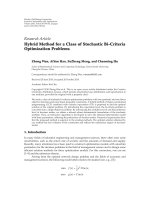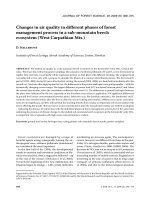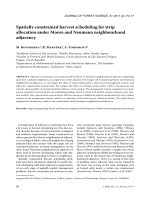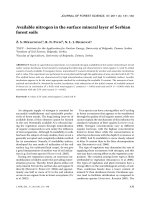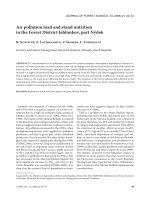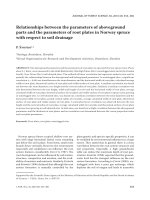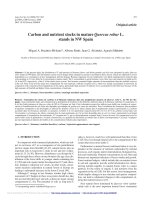Báo cáo lâm nghiệp: "Research on individual parameters for cutting power of woodcutting process by circular saws" docx
Bạn đang xem bản rút gọn của tài liệu. Xem và tải ngay bản đầy đủ của tài liệu tại đây (691 KB, 7 trang )
J. FOR. SCI., 56, 2010 (6): 271–277 271
JOURNAL OF FOREST SCIENCE, 56, 2010 (6): 271–277
e nature of the cutting process for all ways of
mechanical wood machining can be understood
more easily when the elementary factors are known.
Wood crosscutting is the most widespread opera-
tion in the process of forest exploitation; it is used at
tree exploitation, shortening stems and assortment
production. Longitudinal cutting is mainly applied
in subsidiary enterprises (sawmills) and basic wood
industry. Mixed cutting is used in furniture produc-
tion. At the forest exploitation there comes to its
application at the executing the cut on trees underly-
ing harvesting trees by circular saws. Nowadays, the
wood cutting process is considered as a technological
scheme. It consists of several connected and relatively
inseparable parts (M, H 2000). e techno-
logical system called “cutting process” consists of four
parts – subsystems: a workpiece (species of wood,
humidity, density, toughness, elasticity, temperature,
dimensions, etc.), cutting conditions (they represent
the sum of conditions relating to workpiece, cutting
tool and cutting mechanism which are necessary
for initialization of the cutting process), a cutting
mechanism (it is a mechanism of main movement,
feed, number of working movements and procedure
of their performance, thickness and width of a layer
which is cut, cutting angle, speed of cutting move-
ment and feed, cutting forces and friction forces,
performance of motors, etc.) and a cutting tool (cut-
ting-wedge angle, number of teeth, material proper-
ties, surface roughness, cutting edge length, etc.).
Crosscutting wood by circular saws
e penetrating tooth of a circular saw into wood
causes the reciprocal action of forces between the
wood and cutting edge (Fig. 1). e cutting wedge
presses on resisting wood. e result is the load of
the frontal, rounded and back surface of a cutting
wedge. e cutting resistance is a resistance which is
created at the chip separated by a wedge. e cutting
resistance is a reaction to the cutting force, it has the
same size but opposite direction (L 1996).
All resistances that act on the cutting wedge of the
circular saw tooth have the resultant force F which
is called cutting resistance. It consists of the follow-
ing parts:
Research on individual parameters for cutting power
of woodcutting process by circular saws
J. K, M. M
Department of Forest and Mobile Technology, Faculty of Environmental
and Manufacturing Technology, Technical University in Zvolen, Zvolen, Slovakia
ABSTRACT: Nowadays, the wood cutting process looks like a technological scheme consisting of several connected
and relatively inseparable parts. Wood crosscutting is the most widespread operation in the process of forest exploita-
tion; it is used at tree exploitation, shortening stems and assortment production. e article deals with the influence
of the cutting edge geometry of circular saws on the torque and also on the cutting performance at wood crosscut-
ting, therefore there is an influence on the whole cutting process. In the present article measurement procedure, used
measuring devices and the process of result analysis are described in detailed. Knowledge of the wood crosscutting
process and choice of suitable cutting conditions and cutting tools will contribute to a reduction in production costs
and to energy saving.
Keywords: circular saw; cutting edge geometry; cutting power; wood crosscutting
272 J. FOR. SCI., 56, 2010 (6): 271–277
– forces necessary for cutting the mass of a work-
piece by a cutting-wedge during the deformation
of a mass in the surroundings of a cutting edge,
– forces necessary for deflection of chips and sup
-
pression of chip friction against the leading edge
of the tooth,
– forces necessary for suppression of friction on the
back and leading surfaces against the machined
surface.
Defining the value of individual parts of force F
is quite difficult and depends on many aspects. e
part of force F in the direction of cutting feed F
c
is
called cutting force and it is used for practical calcu-
lations of energetic relations during the cutting proc-
ess. e part perpendicular to force F
c
represents the
pressure of the circular saw tooth on the surface of a
machined surface and it is called withdrawal force F
w
.
If its value is positive (going down), the material is
pressed onto the table. If its value is negative (going
up), this force lifts up the material and it is necessary
to provide the stability of the material by a pressing
mechanism (H, R 2004).
Cutting force F
c
acting on the tooth of a circular
saw takes chips at the width b and thickness h. e
cutting force value is then given by the multiplication
of cutting resistance for disintegrated material K and
the surface of chip crosscutting.
F
c
= K × b × h
(N) (1)
e dimension of cutting work Ac on condition
that the cutting resistance is constant in all phases of
the cutting process can be defined as follows:
A
c
= F
c
× l = K × b × h × l
(J) (2)
where:
l – cutting way of a tooth in the material (mm)
e cutting power is defined as the multiplication
of cutting force F
c
and cutting speed v
c
:
P
c
= F
c
× v
c
(W) (3)
Another way of cutting power definition is the
amount of work released per one second. e unit
of power is W (W = N
.
m
.
s
–1
).
A
c
P
c
= –––– (W) (4)
t
We can calculate the cutting power also by means
of the torque according to:
2
×
M
k
×
v
c
P
c
= –––––––––––– (W) (5)
D
where:
M
k
– torque (Nm),
D – diameter of a circular saw (m).
Cutting conditions in the process
of woodcutting by circular saws
According to the shape of a circular saw in the
crosswise cut we can recognize the following circular
saws: flat, relieved (called planning), concurrent (on
the left or on the right side or reciprocal) and saddle
(on the left or right side). e concurrent or saddle
parts of circular saws are defined in the course of a
workpiece feed against the teeth. According to the
cutting course regarding the arrangement of wood
fibres circular saws for crosswise and longitudinal
cutting are used (M, M 1992). ey dif-
fer in the tooth profile and in the way of sharpening.
e tooth profile and the way of sharpening must
correspond to the required performance of a circu-
lar saw and to the quality of machined surface. ey
must be released according to the type of workpiece
(soft, hard wood and other types of workpieces) and
the material of cutting edge (tool steel, cemented
carbide plates).
Maximum revolutions at the maximum speed
100 ms
–1
are set forth in each circular saw. is
Fig. 1. e scheme of circular
saw cutting
where: fz – feed per one tooth
(m), ae – cutting height (m),
vf – feed rate (ms
–1
), vc – cut-
ting speed (ms
–1
),ψ1 – the entry
angle of circular saw (°), ψ2 – the
exit angle of circular saw (°),
Φm – mean angle of cut fibres
(°), hm – max. thickness of a
chip (mm)
Fig. 1. The scheme of circular saw cutting
where: f
z – feed per one tooth (m), ae – cutting height (m), vf – feed rate (m·s
–1
), vc – cutting
speed (m·s
–1
),ȥ
1
– the entry angle of circular saw (°), ȥ
2
– the exit angle of circular saw (°),
ĭm – mean angle of cut fibres (°), h
m
– max. thickness of a chip (mm)
Fig. 2. The scheme of cutting tool geometry (i.e. circular saw geometry)
1 – tooth, 2 – tooth gap, t – spacing of teeth, h
z
– spacing height,
D – cutting clearance angle, E – cutting-wedge angle, J – cutting-edge side rake, G – cutting
angle
J. FOR. SCI., 56, 2010 (6): 271–277 273
speed is not a working speed but it shows operational
reliability which is guaranteed by the manufacturer.
For getting the optimal performance of a circular
saw it is necessary to choose cutting conditions
according to the cut material. e recommended
cutting speeds of a circular saw according to the
material are:
– soft wood 60–100 ms
–1
,
– hard and exotic wood 50–85 ms
–1
.
In the range of recommended cutting speeds for
chosen material there are oriented regarding the
requirements for the cutting surface quality, techno-
logical state of a machine etc. Continuing the recom-
mended cutting speeds does not have any practical
meaning and it is not recommended for economical
reasons. Circular saws have a robust construction
and they are most frequently used in crosscutting
lines when handling thin and medium stems (up to
40–50 cm). eir advantages are high cutting ability,
maintainability and long lifetime.
In practice it is very important to continue the
whole cutting process with the lowest power con-
sumption. More factors influence the power con-
sumption, e.g. the choice of a suitable material for
the cutting tool, its geometry and optimal cutting
conditions (cutting speed v
c
, feed rate v
f
, feed per
one tooth f
z
). e cutting power is very important
and it is the factor of power consumption. Along
with other cutting conditions the cutting angle is
decisive for the performance of tools, machines,
economics of all machining types, machined surface
quality and dimensional exactness of a workpiece.
Cutting angles of a circular saw are shown in Fig. 2.
e wrong cutting angles can diminish the machined
surface quality, accelerate dulling and decrease the
lifetime of a tool, increase the cutting resistance and
influence the lifetime of a machine and efficiency of
the operation (L, Z 1988).
e cutting-wedge angle β. When the cutting-
wedge angle is larger (i.e. the angle of the cutting part
of a tool), the cutting resistance of the material is also
higher. It is better when the cutting angle is as small as
possible but when the cutting angle is smaller than a
certain value, the hardness of the cutting edge is very
low and it becomes weaker and blunts very fast. When
we want to define the cutting-wedge angle, we have
to define the values of angles α and γ. is angle is the
same in cemented carbide plates and in high-speed
steel, because cemented carbide plates are fragile.
e cutting clearance angle α. Mainly friction
between the cutting clearance angle and processed
surface influences the cutting clearance angle. When
this angle is smaller, the friction is higher and vice
Fig. 1. The scheme of circular saw cutting
where: f
z – feed per one tooth (m), ae – cutting height (m), vf – feed rate (m·s
–1
), vc – cutting
speed (m·s
–1
),ȥ
1
– the entry angle of circular saw (°), ȥ
2
– the exit angle of circular saw (°),
ĭm – mean angle of cut fibres (°), h
m
– max. thickness of a chip (mm)
Fig. 2. The scheme of cutting tool geometry (i.e. circular saw geometry)
1 – tooth, 2 – tooth gap, t – spacing of teeth, h
z
– spacing height,
D – cutting clearance angle, E – cutting-wedge angle, J – cutting-edge side rake, G – cutting
angle
Fig. 2. e scheme of cutting tool geometry (i.e. circular saw
geometry)
1 – tooth, 2 – tooth gap, t – spacing of teeth, h
z
– spacing
height, α– cutting clearance angle, β – cutting-wedge angle,
γ – cutting-edge side rake, δ – cutting angle
Fig. 3. e scheme of an experimental
measuring device
1 – working table, 2 – sliding line, 3
– round timber, 4 – gear of belts for
the driving of a circular saw, 5 – elec-
tric motor for the driving of a circular
saw, 6 – bearing cover, 7 – electric
motor for the driving of the material to
the cut, 8 – spindle head of a circular
saw, 9 – circular saw, 10 – T20WN
recorder of torques and revolutions,
11 – GFLL-28 clutch, 12 – S2 force
recorder
Fig. 3. The scheme of an experimental measuring device
1 – working table, 2 – sliding line, 3 – round timber, 4 – gear of belts for the driving of a
circular saw, 5 – electric motor for the driving of a circular saw, 6 – bearing cover, 7 – electric
motor for the driving of the material to the cut, 8 – spindle head of a circular saw, 9 – circular
saw, 10 – T20WN recorder of torques and revolutions, 11 – GFLL-28 clutch, 12 – S2 force
recorder
Fig. 4. The course of M
k
and compressive force to the cutting in wood (beech) crosscutting
Cutting part Feeding part
274 J. FOR. SCI., 56, 2010 (6): 271–277
versa. It is the effect caused by decreasing cutting
clearance angle and surface between the cutting
clearance and processed surface directly behind the
cutting edge. is surface gets gradually increased
with higher blunting of the cutting edge because the
round surface of blunt cutting edge does not cut the
material in the process of chip cutting. It is mainly in
the plain passing the lowest point of the cutting edge
but it is also in the plain lying a little bit higher. e
cutting clearance angle has a direct influence on the
dimension of cutting resistance and the whole work
of cutting. In practice the cutting clearance angle is
between 10° and 30°.
e cutting-edge side rake γ. e cutting-edge side
rake influences the chip process creation and the size
of a chip. It has an important meaning in industrial
chip processing, e.g. in the production of chipboards.
e optimal value depends also on the type of proc-
essed material, direction of fibres and dimension of
feed on edge or possibly on the thickness of a chip.
MATERIAL AND METHODS
The experimental measuring device was devel-
oped for research on wood crosscutting parameters
and on cutting tools. Its scheme is shown in Fig. 3.
e measuring equipment consists of two parts, i.e.
cutting and feeding parts. e cutting part provides
development and transfers the torque to a tool. e
feeding part provides workpiece clamping and feed-
ing wood into the cut.
As it is shown in the scheme, a three-phase asyn-
chronous 7.5 kW electric motor is used. Its torque
is transmitted by the spindle head to a tool (circu-
lar saw). e wood sample is fixed on the plate in
the holder by a lever system which provides safety
holding. e crosswise feeding of the workpiece is
provided by a 5.5 kW electric motor by means of a
safety clutch and a feed screw. An HBM S2 force sen-
sor is placed between the nut and the plate. Cables
transmit measured signals of the force and torque
Table 1. Basic parameters of circular saws
Basic dimensions
Saw
diameter
D (mm)
Saw width
B (mm)
Cutting-
clearance angle
α (°)
Cutting-edge
side rake
(°)
No.
of teeth
Circular saw made of high-speed steel 600 5.4 20 –5, 0, 5, 10 56
Circular saw with cemented carbide plates 600 5.4 15 –10, 0, 10, 20 54
Fig. 4. e course of M
k
and compressive force to the cutting in wood (beech) crosscutting
120
100
80
60
40
20
0
–20
–40
–60
–80
–100
–120
–140
–160
Torque (N
.
m)
Torque (N
.
m)
Power (N)
00.008 00.500 01.000 01.500 02.000 02.500 03.000 03.500 04.000 04.500 05.000 05.500 06.000 06.5000 07.000 07.500 08.100
Time
J. FOR. SCI., 56, 2010 (6): 271–277 275
to a SPIDER-8 measuring centre which is connected
to a PC. e torque sensor HBM T20WN enables to
register the revolutions of a circular saw. Frequency
converters with vector control regulate the revolu-
tions and the power of electric motors.
In experimental tests wood samples 18 cm in diam-
eter and 1.5 m in length were used. e wood samples
were made of beech, oak and spruce. eir moisture
was approximately 45% in spruce, 50–60% in beech
and oak. It was measured by the weighing method.
e samples were cut by circular saws with cemented
carbide plates and made of high-speed steel (their
technical parameters are shown in Table 1).
e measurement of wood (beech and oak) was
done at circular saw revolutions 1,900 revmin
–1
, at
the cutting speed 59.66 ms
–1
and feed rate 152 ms
–1
.
e feed rate in spruce wood was decreased because
of the circular saw jamming in the wood-cutting
process. It was 103 mms
–1
.
RESULTS AND DISCUSSION
A partial purpose of the experiment was to de-
termine the influence of different cutting-edge side
rakes on the torque value and compressive force to
the cut (Fig. 4). e cutting-edge side rake influenced
cutting resistance and the whole process of wood
crosscutting. The results were processed by the
Conmes Spider program.
From the torque M
k
course at cutting of beech by a
circular saw with cemented carbide plates it was pos-
sible to see a great increase in its value at the begin-
ning of the penetration of a tool (circular saw) into the
cut, then there was a certain decrease in this value,
which was caused by the inertia of a circular saw, and
then following fixation of the cutting process. en
the cutting process ran at a certain constant value (the
torque value changed very little), only at the end of
the cutting process the value reached the state when
the circular saw rotated without any load. e course
of torque M
k
in the cutting process of circular saws
made of high-speed steel was characterized by a high
increase to the maximal value, then it decreased a lit-
tle to a certain value and finally it decreased rapidly,
which was caused by cutting out the wood.
From the obtained results of the torque M
k
at dif-
ferent cutting-edge side rakes of circular saws with
cemented carbide plates and circular saws made
of high-speed steel in different types of wood we
deduced the maximal values of M
k
in the particular
measurements and we carried out the analysis of
basic statistical results (Table 2).
Table 2. Arithmetic means of maximal values of P
c
for the particular values of cutting-edge side rake on circular saws
Species of wood/
cutting-edge side rake
(°)
Value of cutting power P
c
(kW)
circular saw made of high-speed steel circular saw with cemented carbide plates
10 5 0 –5 20 10 0 –10
Beech 3.5875 3.8342 4.0389 4.0947 3.9813 3.8919 3.9554 4.0011
Oak 3.7427 3.8898 4.1126 4.1305 4.0648 3.7805 3.9057 4.0131
Spruce 3.8063 3.9833 4.1245 4.1046 4.2219 3.9077 3.9833 4.1921
Fig. 5. e value of cutting performance P
c
in the process
of wood crosscutting by a circular saw made of high-speed
steel
Fig. 6. e value of cutting performance P
c
in the process of
wood crosscutting by a circular saw with cemented carbide
plates
3.60
3.80
4.00
4.20
u
tting Power Pc (kW)
10°
5°
0
°
3.20
3.40
3.60
3.80
4.00
4.20
Beech
Oak
Spruce
Cutting Power Pc (kW)
10°
5°
0°
-5°
–5
3.50
3.60
3.70
3.80
3.90
4.00
4.10
4.20
4.30
Beech Oak S
p
ruce
Cutting Power Pc (kW)
20°
10°
0°
-10°
–10
P
c
P
c
276 J. FOR. SCI., 56, 2010 (6): 271–277
en we created the graphical evaluation of arith-
metic means of maximum values M
k
, which gives
a better overview of obtained results. e value of
cutting power is calculated from the torque due to
the diameter of a circular saw D = 600 mm and the
cutting speed
v = 59.66 m
.
s
–1
.
To determine reciprocal dependences of more
parameters regarding the power consumption of
the woodcutting process by circular saws (torque
and maximum power were chosen as criteria) multi-
factorial analysis of variance ANOVA was used. We
wanted to find out reciprocal statistical dependences
between maximum power (as dependent variable),
wood type, type of circular saw and the cutting-edge
side rake (as independent variable). ere is an as-
sumption that these parameters can influence each
other. For each physical parameter the results were
statistically evaluated by three-factor analysis of
variance. We decided to consider only two values of
cutting-edge side rake, i.e. 0° and 10°, as important.
e reason was that negative values of the cutting-
edge side rake of a circular saw were the values that
were the most unfavourable. Graphical and statisti-
cal evaluations are shown in Figs. 4–6.
From the input factors of the cutting process (wood
type, cutting-edge side rake, type of a circular saw) it
is possible to definitely generalize as follows:
– wood type is an important factor influencing
power consumption in the cutting process and
cutting power,
– the cutting-edge side rake of a circular saw is another
important factor influencing cutting power P
c
,
– of all those factors the change of circular saw type
(with the same geometry) has the highest influ-
ence on cutting power.
e evaluation of the above-mentioned statistical
results of measurements for the values of cutting
Fig. 7. Influence of the cutting-edge side rake of
a circular saw on the cutting power according
to the type of wood species
Fig. 8. Influence of the cutting-edge side rake of
a circular saw on the cutting power according
to the type of circular saw
4.10
4.05
4.00
3.95
3.90
3.85
3.80
3.75
3.70
BK DB SM
Tree species
Pc
Angle 0°
Angle 10°
4.3
4.2
4.1
4.0
3.9
3.8
3.7
3.6
3.5
3.4
3.3
SK HSS
Disc
Pc
Angle 0°
Angle 10°
J. FOR. SCI., 56, 2010 (6): 271–277 277
power P
c
at individual cutting-edge side rakes of
circular saws, wood type and type of circular saw
confirmed that the best value of the cutting-edge
side rake at wood crosscutting by circular saws with
cemented carbide plates and circular saws made of
high-speed steel, where the positive value for cut-
ting-edge side rake (10°) is also at wood type what
the confirmation of recent results in the theory of
crosswise wood cutting is.
CONCLUSION
In practice it is very important that the whole proc-
ess of wood crosscutting should run with the lowest
power consumption. ere are many factors which
influence its power consumption, e.g. material of the
cutting tool, its geometry and optimal cutting forces
(cutting speed v
c
, feed rate v
f
). e cutting power is
a very important factor of power consumption. e
utilization of circular saws with unsuitable technical
and technological parameters in the given conditions
of work can be expressed by following deficiencies:
fast circular saw wearing and bad quality of the cut,
higher power consumption, higher wood consump-
tion in the process of production because big addi-
tions for machining are necessary.
R efe renc es
H J., R M. (2004): Comparison of the theoreti-
cal calculation of resistance in cutting particleboards with
an experiment. In: Chip and Chipless Wood-cutting ’04.
Book of Presentations IV. Chip and Chipless Wood-cutting.
Starý Smokovec, 14.–16. October 2004. Zvolen, Technická
univerzita vo Zvolene: 99–104. (in Czech)
L J. (1996): eory and Technique of Wood Processing.
Zvolen, Matcentrum: 626. (in Slovak)
L J., Z B. (1988): Processing and Cutting of
Wood Materials. Materials for practice. Zvolen, Technická
univerzita vo Zvolene. (in Slovak)
M J., H J. (2000): eory of Wood Cutting. Zvolen,
Technická univerzita vo Zvolene. (in Slovak)
M M., M J. (1992): eory and Construction of
Forest Machines 1. Zvolen, Technická univerzita vo Zvolene.
(in Slovak).
Received for publication September 23, 2009
Accepted after corrections November 9, 2009
Fig. 9. Final interaction of the cutting-edge side
rake of a circular saw, wood species and type of
circular saw in relation to the cutting power
Corresponding author:
Ing. J K, Ph.D., Technická univerzita vo Zvolene, Fakulta environmentálnej a výrobnej techniky,
Katedra lesnej a mobilnej techniky, T. G. Masaryka 24, 960 53 Zvolen, Slovensko
tel.: + 421 455 206 517, fax: + 421 045 532 0015, e-mail:
4.2
4.1
4.0
3.9
3.8
3.7
3.6
3.5
Tree species BK DB SM BK DB SM
Disc: SK Disc: HSS
P
c
Angle 0°
Angle 10°
